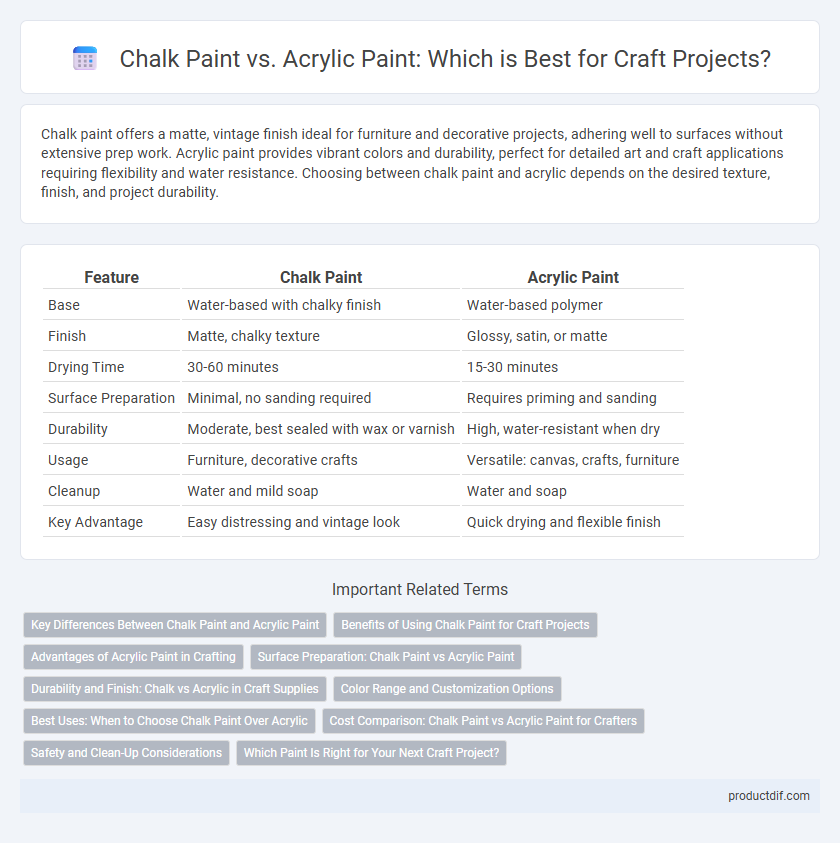Chalk paint offers a matte, vintage finish ideal for furniture and decorative projects, adhering well to surfaces without extensive prep work. Acrylic paint provides vibrant colors and durability, perfect for detailed art and craft applications requiring flexibility and water resistance. Choosing between chalk paint and acrylic depends on the desired texture, finish, and project durability.
Table of Comparison
| Feature | Chalk Paint | Acrylic Paint |
|---|---|---|
| Base | Water-based with chalky finish | Water-based polymer |
| Finish | Matte, chalky texture | Glossy, satin, or matte |
| Drying Time | 30-60 minutes | 15-30 minutes |
| Surface Preparation | Minimal, no sanding required | Requires priming and sanding |
| Durability | Moderate, best sealed with wax or varnish | High, water-resistant when dry |
| Usage | Furniture, decorative crafts | Versatile: canvas, crafts, furniture |
| Cleanup | Water and mild soap | Water and soap |
| Key Advantage | Easy distressing and vintage look | Quick drying and flexible finish |
Key Differences Between Chalk Paint and Acrylic Paint
Chalk paint features a matte, chalky finish with excellent adhesion to various surfaces without priming, making it ideal for distressed and vintage-style projects. Acrylic paint offers vibrant, glossy colors with superior durability and water resistance, suitable for detailed artwork and outdoor crafts. The primary distinctions lie in texture, finish, surface preparation, and durability, guiding crafters' choice based on project requirements.
Benefits of Using Chalk Paint for Craft Projects
Chalk paint offers a unique matte finish that enhances the vintage and shabby chic look sought in many craft projects. Its excellent adhesion properties eliminate the need for extensive surface preparation, making it ideal for upcycling furniture and decorative items. This paint also sands easily, allowing for smooth distressing effects that add character to finished pieces.
Advantages of Acrylic Paint in Crafting
Acrylic paint offers superior versatility and durability in crafting, adhering effectively to various surfaces including wood, fabric, and ceramics. Its fast-drying nature enables quicker project completion and allows layering without smudging. Acrylics also provide vibrant, long-lasting colors that resist fading, making them ideal for detailed and durable craft projects.
Surface Preparation: Chalk Paint vs Acrylic Paint
Surface preparation for chalk paint requires minimal sanding or priming due to its excellent adhesion to various surfaces, including wood, metal, and glass. Acrylic paint demands thorough cleaning and often priming or sanding of the surface to ensure proper adhesion and durability. Chalk paint's versatility in surface preparation makes it ideal for quick, creative projects, while acrylic paint's prep process ensures a long-lasting, smooth finish.
Durability and Finish: Chalk vs Acrylic in Craft Supplies
Chalk paint offers a matte, velvety finish with moderate durability, making it ideal for vintage or distressed craft projects, while acrylic paint provides a glossy, smooth finish with superior durability and water resistance, suitable for outdoor and frequent-use items. The porous nature of chalk paint means it often requires a protective sealer for enhanced longevity, whereas acrylic paint typically withstands wear and fading without additional coatings. Craft enthusiasts choose chalk paint for textured, rustic effects and acrylic paint for vibrant colors and lasting protection.
Color Range and Customization Options
Chalk paint offers a limited but soft, matte color palette ideal for vintage and shabby-chic styles, while acrylic paint provides an extensive and vibrant color range suitable for detailed craft projects. Customization with chalk paint often involves blending with pastels or distressing techniques to achieve unique finishes, whereas acrylic paint supports a wide variety of additives like texture gels, mediums, and varnishes for diverse effects. Artists and crafters benefit from acrylic paint's versatility in mixing colors and customizing finishes compared to the more specialized, rustic appeal of chalk paint.
Best Uses: When to Choose Chalk Paint Over Acrylic
Chalk paint excels in creating a matte, vintage finish ideal for furniture makeover and decorative crafts requiring a distressed or shabby-chic look. It adheres well to porous surfaces like wood, plaster, and canvas without extensive prep work, making it perfect for DIY upcycling projects. Acrylic paint, with its glossy finish and water resistance, is better suited for detailed artwork and outdoor applications.
Cost Comparison: Chalk Paint vs Acrylic Paint for Crafters
Chalk paint typically costs more per quart than acrylic paint, with prices ranging from $15 to $25 compared to $5 to $15 for acrylics, making acrylic paint a more budget-friendly option for large craft projects. Chalk paint's higher price is often justified by its unique matte finish and minimal prep work, reducing the need for priming and sanding. Acrylic paint offers greater versatility and faster drying times, which can save time and indirectly reduce costs in crafting.
Safety and Clean-Up Considerations
Chalk paint contains fewer toxic chemicals, making it safer for indoor use and suitable for beginners or children. Acrylic paint is water-based and non-toxic, but requires soap and water for effective clean-up, which can be more time-consuming. Both paints offer easy clean-up, but chalk paint typically needs minimal scrubbing and dries faster, reducing exposure to wet surfaces.
Which Paint Is Right for Your Next Craft Project?
Chalk paint offers a matte, velvety finish ideal for distressing and vintage-style projects, while acrylic paint provides vibrant colors and strong adhesion suited for detailed, durable crafts. Consider chalk paint for furniture or decorative items requiring easy distressing and minimal surface prep; acrylic paint is better for canvas, wood, or plastic with a need for flexibility and water resistance. Selecting the right paint depends on your project's material, desired finish, and durability requirements.
Chalk paint vs Acrylic paint Infographic

 productdif.com
productdif.com